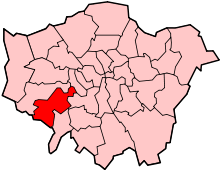Mortlake
| Mortlake | |
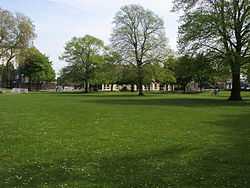 |
|
 Mortlake |
|
| Area | 4.50 km2 (1.74 sq mi) |
|---|---|
| Population | 10,919 (Mortlake and Barnes Common ward 2011)[1] |
| – density | 2,426/km2 (6,280/sq mi) |
| OS grid reference | TQ205755 |
| London borough | Richmond |
| Ceremonial county | Greater London |
| Region | London |
| Country | England |
| Sovereign state | United Kingdom |
| Post town | LONDON |
| Postcode district | SW14 |
| Dialling code | 020 |
| Police | Metropolitan |
| Fire | London |
| Ambulance | London |
| EU Parliament | London |
| UK Parliament | Richmond Park |
| London Assembly | South West |
Coordinates: 51°27′56″N 0°15′51″W / 51.4655°N 0.2643°W
Mortlake is a suburban[2] district of the London Borough of Richmond upon Thames on the south bank of the River Thames between Kew and Barnes. Historically it was part of Surrey and until 1965 was in the Municipal Borough of Barnes. For many centuries it had village status and extended far to the south, to include East Sheen and part of what is now Richmond Park. Its Stuart and Georgian history was economically one of malting, brewing, farming, watermen and a great tapestry works. A London landmark, the Mortlake Brewery or Stag Brewery, is on the edge of Mortlake.
The Waterloo to Reading railway line runs through Mortlake, which has a pedestrianised riverside, two riverside pubs and a village green. The Boat Race finishes at Mortlake every April.
Governance
The Mortlake and Barnes Common ward of the London Borough of Richmond upon Thames has proved highly marginal. In the 2010 local elections local Liberal Democrats lost all three seats to local Conservatives to form an administration on the Council. Richmond Park, the constituency which includes Mortlake, also changed from Liberal Democrat to Conservative in the 2010 general election. The London Assembly constituency South West, which includes Mortlake, includes among its representatives Tony Arbour (Con).
History
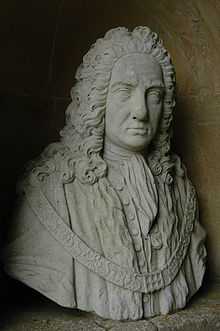
Mortlake lay in the hundred (county subdivision) of Brixton all of which faded into obscurity.[3]
According to Domesday Book (1086) the manor and parish of Mortlage (by which name Mortlake was then known)[4] was held by Archbishop Lanfranc of Canterbury when its assets were: 25 hides; 1 church, 2 mills worth £5, 1 fishery, 33 ploughs, 20 acres (81,000 m2) of meadow, wood worth 55 hogs. It rendered a large £38 plus 4s 4d from 17 houses in London, 2s 3d from houses in Southwark and £1 from tolls at Putney per year to its feudal system overlords.[4] The manor belonged to the Archbishops of Canterbury until the time of Henry VIII, when it passed by exchange to the Crown. From the early part of the 17th century until after the English Civil War, Mortlake was celebrated for the manufacture of tapestry, founded during the reign of James I at the Mortlake Tapestry Works.
Mortlake lost 732 acres of land to the newly created hunting ground, Richmond Park, when it was enclosed by Charles I in 1637. Other parishes also lost land to the new park, but Mortlake's loss, in terms of acreage, was the greatest.[5]
Colston House's forebear was built by Thomas Cromwell, Earl of Essex then acquired by Edward Colston, major benefactor and investor to the port city of Bristol. This was pulled down in 1860. John Barber, Lord Mayor in 1733, a suspected Jacobite opposed to the 'Georgian' House of Hanover but Member of Parliament for the City on the strength of his opposition to Walpole's protectionist excise scheme, was buried in Mortlake in 1741. He had given land to extend the churchyard. Sir Henry Taylor, KCMG, the dramatic poet, lived in Mortlake in the 19th century.[6]
Sir John Barnard, Lord Mayor of London in the year 1737 and also an MP, used public addresses and private campaigns to outstanding effect in supporting the government against the Jacobite movement in 1745.[6]
Since 1845, the Oxford and Cambridge Boat Race has had its finish point at Mortlake, marked by the University Boat Race stone just downstream of Chiswick Bridge. Several other important rowing races over the Championship Course also either start or finish at the stone. The first National School in Mortlake was built providing compulsory education at primary level in 1869, followed by an infants school in 1890 and county level, into secondary level school in 1906.
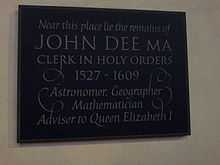
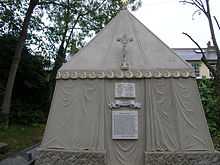
Mortlake's relatively small bus garage, in Avondale Road, was closed in 1983. Much of the site was rebuilt as housing but a small area near the railway was retained as a turning point for buses, with toilets and a small office. Mortlake garage had opened very early in the 20th century and originally served horse buses on what later became London Buses route 9. In later years the stables were converted into the traffic office.
People
Mortlake's most famous former resident is John Dee (1527–1608/09), mathematician, astronomer, astrologer, alchemist and adviser to Queen Elizabeth I, who lived at Mortlake from 1565 to 1595 except for the six years between 1583 and 1589 when he was travelling in Europe.[7] His house no longer exists but it became the Mortlake Tapestry Works and at the end of the 18th century was a girls' school.[7]
The cemetery of St Mary Magdalen’s Roman Catholic Church Mortlake contains the tomb of Sir Richard Burton.[8] Former British Prime Minister Henry Addington who, as Lord Sidmouth, was Ranger of Richmond Park, and after whom the park's Sidmouth Plantation is named, is buried at St Mary the Virgin Mortlake.[9][10]
Notable landmarks
The building next to Mortlake Station, now occupied by a classic car showroom, contains Queen Victoria's old waiting room which she used when coming to visit her family in Richmond Park.
Economy
The town is mostly residential commuter town with a strong history of self-employed trades as it has traditionally centred its commerce on its foreshortened boundary, the Upper Richmond Road, arguably half part of East Sheen. Some businesses on the north side of the Upper Richmond Road make reference to the old ecclesiastical and ward boundaries supported by their still Mortlake side streets.[11] East Sheen was once a manor in the parish of Mortlake and since early times an economic forum, and now a dining and convenience hub of the two districts. The Victoria County History written 1910 to 1912 says on this topic refuses to list East Sheen as a parish, describes its detailed history under Mortlake and states the parish was "now connected with Barnes on one side and with New Richmond on the other".[12][6] With the advent of motor transport Mortlake's winding high street also known as the Lower Mortlake Road has been of brewery and residential use.
Stag Brewery or Mortlake Brewery
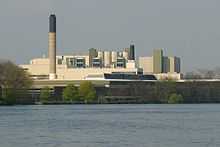
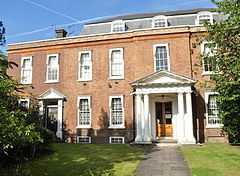
In the 1840s Charles James Philips and James Wigan acquired Mortlake Brewery, which had existed since the fifteenth century.[13]
In 1889 the brewery was acquired by James Watney & Co., which in 1898 became Watney Combe & Reid after acquiring Messrs. Combe Delafield and Co. and Messrs. Reid and Co. When Watney's Stag Brewery in Victoria, London, was demolished in 1959, the name became officially applied to Mortlake Brewery. Being the last phase of The Boat Race which refers to all the traditional local names, it is still widely referred to as the Mortlake Brewery.[13]
The brewery became part of Scottish Courage, and is now leased to Anheuser-Busch Europe Ltd and produces Budweiser pale lager. On 6 January 2009, InBev Anheuser-Busch said that the company was proposing to close the Stag Brewery in 2010 as a result of a merger between InBev and Anheuser-Busch,[14] although this has since been postponed until at least 2014.[15] The closure could lead to the loss of 180 full-time equivalent (FTE) jobs at the brewery.
Amenities
Mortlake affords an undistracted view of the river as its riverside promenade is set by its buildings including the brewery, unlike the embankment style roads along other London banks such as in Barnes until Barnes Bridge.
The two large pubs at either end of the 'riverside prom' are not listed buildings:
- The White Hart
- The Ship
Education
Places of worship
- St Mary Magdalen’s Roman Catholic Church Mortlake
- St Mary the Virgin Mortlake (Anglican)
Transport
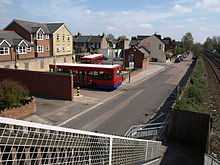
Adjoining districts
- Barnes
- Chiswick (Grove Park after which is Old Chiswick or Strand-on-the-Green, depending on direction)
- East Sheen
- Kew
Nearest railway stations
These are minor stops on the Waterloo to Reading Line which has three branch lines, to Windsor, to Weybridge and back to the London terminus via Kingston upon Thames.
This railway is a narrow bisector of the settlement, being generally on the flat with its streets, which tend to run perpendicular to it.
Buses
The town was for many years the western terminus of the 9 bus route. The route was replaced by the 209 in 1997. The 419 (Richmond - Hammersmith; formerly the R69) also serves the area.
Demography and housing
To give an equal councillor number and electorate, the ward here takes back from the Middle Ages eastern parts since before the Tudor period considered part of Barnes.[16]
| Ward | Detached | Semi-detached | Terraced | Flats and apartments | Caravans/temporary/mobile homes/houseboats | Shared between households[1] |
|---|---|---|---|---|---|---|
| Mortlake and Barnes Common | 167 | 547 | 1,765 | 2,453 | 1 | 8 |
| Ward | Population | Households | % Owned outright | % Owned with a loan | hectares[1] |
|---|---|---|---|---|---|
| Mortlake and Barnes Common | 10,919 | 4,771 | 27 | 32 | 185 |
References
- ↑ 1.0 1.1 1.2 Key Statistics; Quick Statistics: Population Density Office for National Statistics
- ↑ A City of Villages: Promoting a sustainable future for London's suburbs (PDF). SDS Technical Report 11 (Greater London Authority). August 2002. ISBN 1 85261 393 9. Retrieved 16 January 2014.
- ↑ H.E. Malden (editor) (1912). "The hundred of Brixton: Introduction and map". A History of the County of Surrey: Volume 4. Institute of Historical Research. Retrieved 21 December 2013.
- ↑ 4.0 4.1 Lysons, Daniel (1792). "Mortlake". The Environs of London: volume 1: County of Surrey. British History Online. Retrieved 27 July 2013.
- ↑ Brown, Maisie (1997). Barnes and Mortlake Past, with East Sheen. Historical Publications. p. 18. ISBN 0 948667 46 X.
- ↑ 6.0 6.1 6.2 H.E. Malden (editor) (1912). "Parishes: Mortlake". A History of the County of Surrey: Volume 4. Institute of Historical Research. Retrieved 21 December 2013.
- ↑ 7.0 7.1 "Dee's House". John Dee of Mortlake Society. Retrieved 17 October 2012.
- ↑ "Mausoleum of Sir Richard and Lady Burton, Churchyard of St Mary Magdalen". English Heritage. Retrieved 2 November 2013.
- ↑ "Henry Addington (1757–1844) First Viscount Sidmouth". Napoleon & Empire. Retrieved 18 October 2012.
- ↑ Burton's Mausoleum Historic England. "Details from listed building database (1065392)". National Heritage List for England.
- ↑ Memories of Mortlake Retrieved 2013-12-21
- ↑ Mills, A., Oxford Dictionary of London Place Names (2001)
- ↑ 13.0 13.1 Richmond L. and Turton A. (eds.),The Brewing Industry: A Guide to Historical Records, 1990, p.263
- ↑ Times Online: Stag Brewery to close with loss of 180 jobs
- ↑ Fleming, Christine (24 May 2011). "Mortlake's Stag Brewery to stay open until 2014". Richmond and Twickenham Times. Retrieved 9 November 2012.
- ↑ H.E. Malden (editor) (1912). "Map of the parish boundaries. Introduction to history of the hundred". Part of the Victoria County History Surrey: Volume 4. Institute of Historical Research. Retrieved 21 December 2013.
External links
- Barnes and Mortlake History Society
- Mortlake Community Association
- Mortlake Online
- St Mary Magdalen's Church
- St Mary the Virgin, Mortlake
- Classic Chrome Ltd
| ||||||||||||||||||||||||||||||||||||
